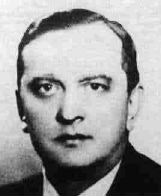

Stefan Banach attended various primary and secondary schools in Kraków.
During his first few years at the Gymnasium Banach achieved first class grades, with mathematics and natural sciences being his best subjects. He got poorer grades later, but still passed graduated in 1910.
Banach left Kraków and went to Lvov where he studied engineering at Lvov Technical University. It is almost certain that Banach, without any financial
support, had to support himself by tutoring. At the outbreak of World War I, a few months after he graduated, he left Lvov.
During the war he worked building roads but also spent time in Kraków where he earned money by teaching in the local schools. He also attended mathematics lectures at the Jagiellonian University. A chance meeting with Steinhaus led him to do mathematics again.
Steinhaus told Banach of a problem which he was working on without success. After a few days Banach had the main idea for the required counterexample and Steinhaus and Banach wrote a joint paper, which they presented for publication. The war delayed publication but the paper,
Banach's first, appeared in 1918. From the time that he produced these first results with Steinhaus, Banach started to produce important mathematics papers at a rapid rate. It was also through Steinhaus that Banach met his future wife, to be married in 1920.
On Steinhaus's initiative, the Polish Mathematical Society was set up in 1919. Banach lectured to the Society twice during 1919 and continued to produce top quality research papers.
Banach was offered an assistantship to Lomnicki at Lvov Technical University in 1920. He lectured there in mathematics and submitted a dissertation for his
doctorate. This was, of course, not the standard route to a doctorate, for Banach had no university mathematics qualifications.
However, an exception was made to allow him to submit his thesis.
In his dissertation, written in 1920, he defined axiomatically what today is called a Banach space. The name Banach algebras were also named after him.
The importance of Banach's contribution is that he developed a systematic theory of functional analysis, where before there had only been isolated results
which were later seen to fit into the new theory. The theory generalised the contributions made by Volterra, Fredholm and Hilbert on integral equations. This thesis is sometimes called the birth of functional analysis.
He was appointed Professor Extraordinary of mathematics in 1922, and promoted to full professor. As well as continuing to produce a stream of important papers, he wrote arithmetic, geometry and algebra texts for high schools. He also was very
much involved with the publication of mathematics. In 1929, together with Steinhaus, he started a new journal Studia Mathematica, and Banach and
Steinhaus became the first editors.
Another important publishing venture, begun in 1931, was a new series of Mathematical Monographs. The first volume in the series was written by Banach and appeared in 1932. It was a French version of a volume he originally published in Polish in 1931, and quickly became a
classic. In 1936, Banach gave a plenary address at the International Congress of Mathematicians in Oslo. In this address he described the work of the whole of the Lvov school, and he also spoke of the plans which they had to develop their ideas further. Banach also collaborated with Kuratowski and they wrote some joint papers during this period.
Banach founded modern functional analysis and made major contributions to the theory of topological vector spaces. In addition, he contributed to measure
theory, integration, the theory of sets, and orthogonal series.
Banach proved a number of fundamental results on normed linear spaces, and many important theorems are today named after him. There is the Hahn-Banach
theorem on the extension of continuous linear functionals, the Banach-Steinhaus theorem on bounded families of mappings, the Banach-Alaoglu theorem, the
Banach fixed point theorem and the Banach-Tarski paradoxical decomposition of a ball.
The Banach-Tarski paradox was a major contribution to the work being
done on axiomatic set theory around this period.
In 1939, just before the start of World War II, Banach was elected as President of the Polish Mathematical Society. At the beginning of the war Soviet troops occupied Lvov. Banach had been on good terms with the Soviet mathematicians before the war started, and he was treated well by the new Soviet administration. He was allowed to continue to hold his chair at the university and he became the Dean of the Faculty of Science at the university.
The Nazi occupation of Lvov in June 1941 meant that Banach lived under very difficult conditions. He was arrested under suspicion of trafficking in German currency but released after a few weeks. Banach planned to go to Kraków after the war to take up the chair of mathematics at the Jagiellonian University, but he died in Lvov in 1945 of lung cancer.